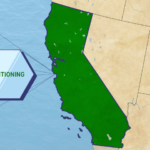
California Cap-and-Trade: Positive Market Outlook Ahead of Upcoming Market Reforms
Oktay Kurbanov at Climate Finance Partners
California has long been a national leader in ambitious climate policy, having set its original greenhouse gas (GHG) reduction targets in 2006 and implemented its cap-and-trade program in 2013. Prices for California carbon allowances (CCAs) have moved up strongly in the last two years, though we believe the outlook for continued price gains remains very positive. With the implementation of new market policies that introduce supply-tightening measures and continued allowance demand from steady emissions, we see continued support for the KraneShares California Allowance Strategy ETF (Ticker: KCCA).
Intro: Favorable supply-demand dynamics at play
On the supply side, California is about to undergo a market reform process that should lead to reduced supply.
California set a 2045 carbon neutrality target last year, and there have been numerous indications that its cap-and-trade program will be tightened in order to meet this target. A recent update to its Climate Change Scoping Plan, the state’s overarching plan to meet its emissions targets, called for increasing the stringency of its 2030 emissions target that determines cap-and-trade supply. Since then, key policymakers have indicated that the cap-and-trade program will be recalibrated to be more aggressive as soon as 2025. Additionally, they are considering other revisions to address the market’s historic surplus and future carbon offset use. Altogether, these revisions point to reduced market supply and upward price pressure for CCAs.
At the same time, California policymakers are assuming ambitious reductions in GHG emissions that we believe are unrealistic, leading emissions demand to surprise to the upside.
California’s Scoping Plan included a detailed assessment of how emissions would need to fall in each sector in order to meet its carbon neutrality target. This included a view that overall transportation activity will decline precipitously by 2030, despite no mandatory policy to encourage it. Additionally, it assumed considerable penetration of Carbon Capture and Storage (CCS) in hard-to-abate industrial sectors within the next five years. Cap-and-trade prices need to rise considerably to encourage this new technology, and cap-and-trade market rules need to be adjusted to account for captured carbon. Overall, we believe that CCA demand from unrealized emissions reductions will be far stronger than what policymakers are currently assuming, which also suggests a bullish outlook for CCA prices.
Below we go into greater detail on potential market reforms and expected industry trends for sectors covered under the program.
Potential upcoming market reforms that would reduce California carbon market supply
- Expected lower market caps by 2025
- Anticipated extension of the Cap-and-Trade beyond 2030
- Address market oversupply with an additional supply adjustment mechanism
- Tightening requirements for inclusion of carbon offsets
The 2022 Scoping Plan update set the stage for carbon market tightening
The California Air Resources Board (CARB) develops and updates its Climate Change Scoping Plan every five years (as required by law) to understand “the transformations needed across our society and economy to reduce emissions and reach our climate targets."1 Specifically, the 2022 update “identifies a technologically feasible and cost-effective path to achieve carbon neutrality by 2045,”2 referred to in the document as the Scoping Plan Scenario. In developing this scenario, CARB assumed that California’s GHG emissions in 2030 would need to be 48% lower vs. 1990 levels3 to remain on the carbon neutrality path, which is a stronger emissions reduction target than the 40% target that is currently on the books. CARB also published a Reference Scenario based solely on existing policies that are already required. Figure 1 below illustrates California’s long-term emissions trends under both scenarios.

The Scoping Plan Scenario’s emissions trajectory is considerably more aggressive than the Reference (business as usual) scenario. However, as we discuss below, we believe that the state will be challenged to reduce emissions in line with this goal, creating demand-side price pressure for CCAs. In parallel, California’s cap-and-trade system plays a crucial role in keeping the state on its path toward neutrality, realigning itself with higher ambitions by tightening the emission cap, i.e., putting tightening pressure on the CCA supply side. Combined, these two effects should tighten California's carbon market and be supportive of CCA prices going forward.
CARB looking to lower market caps by 2025
Since the release of the Scoping Plan, CARB has provided additional assurances that it plans to tighten the cap-and-trade program in line with a stronger 2030 target. At an early-March meeting of the California Joint Legislative Committee on Climate Change Policies, CARB Chair Liane Randolph noted her view that the cap-and-trade program needs to be more aggressive and that both cap-and-trade and LCFS would be recalibrated for a 48% reduction target for 2030.4
CARB has considerable legal authority to run the cap-and-trade program through 2030 “to achieve the maximum technologically feasible and cost-effective reductions in greenhouse gas emissions.”5 As a result, CARB will be able to lower market caps and reduce supply via regulatory reforms, as opposed to a lengthier legislative process. Indeed, CARB recently indicated that it intended to complete the regulatory process to reduce market caps by end of 2024, to take effect in 2025.6 The chart below highlights how market caps could change assuming a 2025 start date under a 48% target. We expect this reduction will lower supply by about 8.7% in the impacted years 2025-2030 and lead to meaningful annual net deficits, putting upward pressure on CCA prices.

Other market reforms to reduce supply
Lower caps are not the only market reform under consideration, though other potential measures may take longer to implement and could require legislative revisions. Nevertheless, as progress is made in these efforts over the next two years of legislative work, we expect CCA prices to react contemporaneously to these measures, with an expected appreciation as the legislature develops.
One of the major risks in achieving the 48% emissions ambition by 2030 is the number of banked (excess) allowances currently in the system. According to California’s Independent Emissions Market Advisory Committee (IEMAC), market participants banked about 321Mt of allowances from the first three WCI compliance periods.7 This amount represents about 90% of the California-Quebec joint emissions cap in 2022. The regulators are concerned that instead of cutting emissions to stay under the cap and achieve emissions reductions, the emitting entities will tap into this extra supply. CARB indicated a willingness to address this oversupply with a report on implications and options due to the state legislature by year-end.8 Potential options include an additional supply adjustment mechanism, whether triggered by price (such as in the Northeast Regional Greenhouse Gas Initiative) or by volume (as in the EU market).
Tightening carbon offset requirements is another measure considered by CARB. California’s cap-and-trade program permits a limited volume of offsets to be used for compliance, which contributes to the overall available market supply. Possible measures include lowering the overall percentage of a compliance obligation that can be met with offsets,9 increasing the requirement that a certain percentage of offsets provide direct environmental benefits to the state (DEBS), or revising the offset protocols – the requirements that offset projects must meet in order to be eligible for use in California. As CARB is considering revising offset protocols in the upcoming rulemaking,10 any of these measures could constrain future offset usage and support CCA demand going forward.
Expected extension of the Cap-and-Trade beyond 2030
We believe that current CCA prices reflect some discount due to uncertainty risk regarding the program’s extension post-2030. Though the cap-and-trade program does not technically expire until 2050,11 CARB’s authority to actively operate and revise the program beyond 2030 will likely require a new legislative initiative. We believe the program will undoubtedly be extended toward at least 2045, considering California’s commitment to its carbon neutrality goals and with the cap-and-trade system as one of its most effective policy tools (as well as a revenue generator). The emissions in 2030 are still expected to be at least 200Mt even if the optimistic Scoping Plan scenario materializes, while the Reference scenario projects them to be around 300Mt. At these levels, there is plenty of room for the cap-and-trade system to contribute in the 2031-2045 period to help move California toward carbon neutrality. Greater clarity on the program's extension should, in turn, provide a boost to CCA prices as the dampening effect from the program uncertainty will be removed.
CCA prices need to rise strongly to encourage the emissions reductions and technological change outlined in the Scoping Plan
We expect that CCA prices need to rise considerably in order to achieve the emissions demand destruction required to achieve California’s 2045 carbon neutrality target. The Scoping Plan included a detailed overview of how emissions in major sectors would need to fall to meet long-term decarbonization targets, which reflected a range of legally binding as well as aspirational policies. However, we believe that many of the assumptions included in this analysis are unreasonable. This suggests that future demand for CCAs may be far stronger than what policymakers expect.
Scoping Plan’s assumed decline in transportation emissions relies very heavily on reduced activity
The transportation sector is responsible for about half of the emissions covered by California’s cap-and-trade program.12 The Scoping Plan places a high emphasis on reducing emissions in this sector, with the Scoping Plan Scenario including a 53% reduction by 2030 vs. 2018. At the same time, this sector lacks relatively easy or quick abatement options, which is why we think the actual emissions from this sector through 2030 will be higher than the optimistic forecasts by state regulators.
Transportation sector emissions are a function of three different variables: technology (i.e., internal combustion engines vs. electric vehicles), fuel (i.e., gasoline vs. biofuels), and overall transport activity measured in vehicle-miles-traveled (VMT). All three variables will need to see considerable shifts to achieve substantive emissions reductions from transportation, as summarized in Table 1.

California has legally binding policies in place to encourage technological shifts, like the Advanced Clean Cars II regulation to ensure that zero-emissions vehicles make up 100% of new vehicle sales by 2035. Likewise, the Low Carbon Fuel Standard (LCFS) program is intended to increase penetration of lower-emitting alternative fuels, such as biofuels. Both policies are included in the Scoping Plan modeling – which assumes that the share of California’s auto fleet comprising electric vehicles rises from 1% in 2018 to 19% in 2030 (with the gains heavily weighted to the back end of the time period), and conventional gasoline and diesel’s share of the fuel mix falls from 96% in 2018 to 71% by 2030.13 14 Both assumptions are more ambitious than the policies currently on the books and imply downward demand for CCAs.
However, the Scoping Plan also included an assumed 25% reduction in per capita VMT vs. 2019 levels by 2030.15 This is the major driver of modeled transportation emissions reductions, as the overall reduction in activity facilitates penetration of EVs and low-emitting fuels. To understand its impact, our partners at Climate Finance Partners (CLIFI) revised the Scoping Plan scenario to include the higher overall transport activity found in the Reference case (averaging 12% higher from 2023-2030), but while holding the Scoping Plan’s scenarios assumptions on EV and biofuels penetration constant. We found that the reduced VMT alone was responsible for nearly 80% of the difference in the Scoping Plan scenario’s 2030 transport sector emissions reductions vs. the Reference case.
In contrast to technology and fuel changes, there is no binding policy in place to reduce California VMT.16 Further, there is no historic precedent for such a large reduction in transportation activity. Figure 3 below illustrates US Federal Highway Administration estimates of California’s historic VMT,17 as well as the implied trend necessary to meet a 25% reduction. VMT rose relatively consistently prior to the pandemic – and continued to do so after it. Indeed, VMT in 2020 represented a 12% decline vs. 2019 levels – less than half of the activity decline that will be required in 2030. We believe that the behavioral change that would lead to such a decline in VMT is unrealistic absent a major rise in CCA prices to encourage it.

Scoping Plan assumes a considerable role for carbon capture and sequestration (CCS) before 2030
The Scoping Plan’s optimistic view of CCS also suggests strong CCA demand through 2030. The Scoping Plan includes CCS to reduce emissions for electricity generation, petroleum refining, and cement production. While the Scoping Plan’s modeling does not have CCS in the electricity sector before 2045, it includes penetration of CCS in the refining and cement sectors as early as 2028 – with particularly strong deployment in refining.18
The inclusion of CCS in the refining sector is especially important for long-term emissions trends, as it is the highest-emitting industrial sector in California, historically responsible for around 10% of all covered emissions. Figure 4 below illustrates the Scoping Plan’s assessment of refinery sector emissions in the reference and Scoping Plan modeled scenarios. The Scoping Plan assumes that refinery sector emissions decline along with VMT reduction due to reduced fuel demand (which, as noted above, we believe is unlikely), with CCS addressing the remainder.

CCA prices will need to rise considerably to encourage the buildout of CCS in these industrial sectors like cement and refining. Notably, the Scoping Plan noted that decarbonizing industrial energy supply (including refining, cement, and other large industrial activities) in California would have an annual average cost above $200/metric ton of CO2 between 2022-2035.19 Ultimately, CCAs will need to rise to higher levels if state policymakers are assuming that CCS is to play a major role in industrial decarbonization. In the Scoping Plan Scenario, 2030 emissions in the sector would be 1.5x higher than with it. Likewise, 2030 refinery sector emissions in the Reference scenario are 2x higher than the Scoping Plan Scenario with CCS included.
At the same time, note that current market rules do not allow increased CCS buildout to actually reduce CCA compliance obligations. The existing cap-and-trade regulations do not allow entities to subtract any carbon sequestered at their facilities from their compliance obligations. While there are efforts to revise these rules, it also highlights that any buildout of new emissions abatement technologies requires not just technological improvements but also an appropriate regulatory infrastructure.
Power generation emissions declines are hampered by projected increases in energy demand
CARB’s Scoping Plan scenario calls for a 16% decline in emissions from power generation from 2022 to 2030 – a sector that has historically been easier to decarbonize by way of coal-to-gas switching. However, this easy route is no longer available in California, where only 0.2% of in-state power generation comes from coal.20 This projection in decline in power emissions is at odds with an expectation of more than 25% growth in 2022-2030 in total electric energy demand across all sectors of California’s economy, driven by both economic growth and increased electrification in other sectors. To avoid increased emissions in the power sector, CARB set ambitious targets in renewable assets build-outs in the 2023-2030 period: solar capacity to rise by over 70%, with a nearly 40% rise in new wind capacity. However, the trend for in-state emissions since 2013 shows that power emissions stubbornly leveled off starting from around 2017, shortly dipping during the pandemic and then rebounding strongly, as can be seen in Figure 5:

In view of this trend, there is a high likelihood that new renewable energy capacity can primarily be used to meet demand growth, not to reduce existing emissions from the sector. A relatively flat emissions trajectory for in-state generation should help support CCA demand from the power sector going forward and thus CCA prices through 2030.
Conclusion
By approving the updated Scoping Plan at the end of 2022, California has shown its commitment to move along an ambitious path toward achieving carbon neutrality by the year 2045, with an intermediate goal of 48% emissions reduction by the year 2030. As we discussed above, in 2023-2024, the state legislature will be working on regulations to significantly tighten allowance supply in its cap-and-trade system to align it with the stated emission reduction goals. At the same time, the Scoping Plan assumes an aggressive reduction in emissions demand across various sectors. We have shown that some of these demand reduction assumptions are unrealistic or problematic, while others, in the case of abatement technologies, can only be realized at higher CCA prices.
In aggregate, these effects should create favored supply-demand dynamics causing annual deficits in the market going forward, leading to a material increase in CCA prices. This is why we think the California compliance market presents a great opportunity for investors to gain exposure to the carbon markets at an attractive price level, with a strong outlook for appreciation potential.
Get exposure to California allowances through KCCA
Our KraneShares California Carbon Allowance Strategy ETF (Ticker: KCCA) provides exposure to the California cap-and-trade market through CCA futures. Beyond having an attractive entry point, CCAs also provide potential portfolio diversification* due to the carbon futures' historically low correlation to other asset classes. In the past year, KCCA has outperformed the global benchmarks, with the fund up 1.66% compared to the S&P 500 down 10.51%. CCA futures saw a muted impact in the wake of the global bank fallout and general risk-off sentiment, with KCCA up 3.19% compared to the S&P 500 down 0.09% month-to-date.21
That said, we believe optimal exposure includes a blend of the different carbon markets for diversification* benefits. In the KraneShares Global Carbon Allowance Strategy ETF (Ticker: KRBN), which is comprised of the four largest carbon allowance futures markets, we have a roughly 30% allocation to CCAs. Another 60% is allocated to European Union allowance futures, the largest and most mature carbon market. Additionally, KBRN provides exposure to the Regional Greenhouse Gas Initiative (RGGI), a bloc of eleven Northeastern US states, which is set to grow further with the addition of new states, potentially including Pennsylvania, North Carolina, and the new economy-wide New York state market. In 2021, we added the UK ETS, which spun off of the EU market following Brexit and, as with the other markets, should see further market tightening to meet its higher emissions targets. There is a consistent theme across markets for implementing policy changes that raise climate ambition and introduce supply-tightening measures, which collectively should put upward price pressure on these allowance markets.
Please click here for KCCA standard performance and top ten holdings, risks, and other fund information.
Please click here for KRBN standard performance and top ten holdings, risks, and other fund information.
*Diversification does not ensure a profit or guarantee against a loss.
- California Air Resources Board, “2022 Scoping Plan for Achieving Carbon Neutrality” (Scoping Plan), November 16, 2022, p. 23.
- Scoping Plan p. 24.
- Scoping Plan p. 71.
- Carbon Pulse, "CCAs pivot higher after California ARB chair says carbon market stringency must increase," March 2, 2023.
- California Legislative Information, "Assembly Bill No. 398, CHAPTER 135," July 25, 2017.
- Carbon Pulse, "California’s ARB to vote on tightening cap-and-trade programme by end-2024," February 28, 2023.
- 2021 IEMAC Annual Report, "2021 ANNUAL REPORT OF THE INDEPENDENT EMISSIONS MARKET ADVISORY COMMITTEE," January 20, 2022.
- California Air and Resource Board, "Important Process Information Regarding Cap-and-Trade Regulatory Updates," February 28, 2023.
- Compliance entities may use eligible offsets to meet up to 4 percent of their compliance obligation from 2021-2025, and 6 percent for emissions from 2026-2030. Additionally, no more than half of the usage limit may be sourced from projects that do not provide direct environmental benefits in the state (DEBS).
- California Air and Resource Board, "Important Process Information Regarding Cap-and-Trade Regulatory Updates," February 28, 2023.
- California’s cap-and-trade regulation includes specific annual market caps through 2031, with a predetermined formula to set annual caps from 2032-2050. California Air and Resource Board, "Unofficial electronic version of the Regulation for the California Cap on Greenhouse Gas Emissions and Market-Based Compliance Mechanisms," p. 110, April 2019.
- cCarbon, "Annual covered emissions data," 12/31/2021.
- See Scoping Plan excel, "Energy Demand."
- Computed on an energy basis, not a volumetric basis.
- Scoping Plan pp.193-194.
- P. 194 of Scoping Plan: “While CARB has included VMT reduction targets and strategies in the Scoping Plan and appendices, these targets are not regulatory requirements, but would inform future planning processes. CARB is not setting regulatory limits on VMT in the 2022 Scoping Plan; the authority to reduce VMT largely lies with state, regional, and local transportation, land use, and housing agencies, along with the Legislature and its budgeting choices.”
- "National Traffic and Highway Statistics." Federal Highway Administration, U.S. Department of Transportation, 2021.
- See Scoping Plan excel, "Carbon Removal Target."
- Scoping Plan Table 3-11, p. 155.
- 2021 Total System Electric Generation." California Energy Commission, 2022.
- Data from Bloomberg as of 3/22/2023.

















